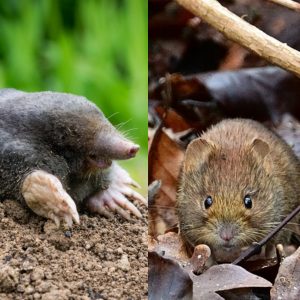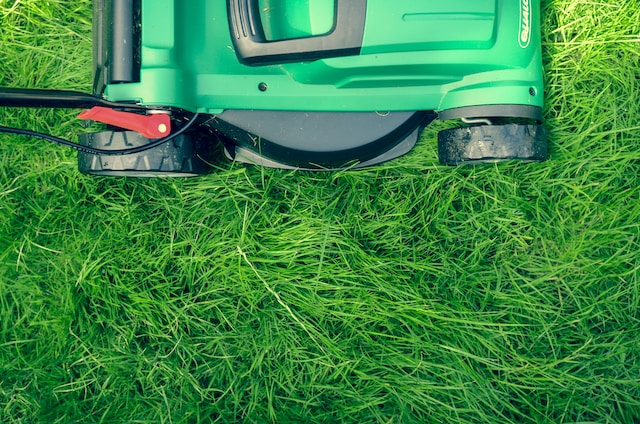You’ve worked hard to maintain a healthy lawn or backyard, and it’s disappointing to see your efforts disturbed by outdoor pests! Meadow voles are pesky animals that eat grass, roots, and bulbs. These pests can wreak havoc in your yard by destroying the lawn and creating unattractive holes and trails on the grass. To protect your backyard and plants, check out these tips to keep meadow voles at bay.
What is a Meadow Vole?
While meadow voles may bear a resemblance to mice, these rodents have their own distinct characteristics. Unlike mice, meadow voles thrive in outdoor environments, even during the harsh winter months. They leave behind extensive tracks in your yard as they forage for food, creating visible trails that connect to their underground burrows, offering them a quick escape.
A meadow vole’s lifespan is relatively short, typically ranging from four to six months. Numerous predators, such as owls, foxes, snakes, and even domesticated cats, constantly threaten their survival. Additionally, efforts to control pests also contribute to curtailing their lifespans.
It’s crucial to recognize the significant differences between voles and moles, especially when it comes to pest control. Although both can cause damage to your yard, their behaviors and dietary preferences diverge significantly. Moles, being larger mammals, primarily feed on insects, while voles have a voracious appetite for seeds, grass, and plants.
When it comes to effective pest control, understanding the distinctions between these pests is crucial. By identifying the specific rodent causing trouble in your yard and implementing appropriate control measures, such as trapping or exclusion methods, you can help mitigate the damage they cause and create a more pest-free environment.

Fixing Vole Damage
When a meadow vole burrows through the ground, it can wreak havoc on your grass and leave visible damage aboveground. They destroy the vegetation, exposing the soil and ruining all of your hard work, which can be quite a nuisance if you’ve put considerable effort into maintaining the pristine appearance of your lawn.
Not only does a vole pose a threat to your grass, but if you have crops on your property, these pests can inflict serious damage. Snacking on seeds, roots, and plant bulbs, voles can leave a significant dent in your backyard garden if left unchecked.
Fortunately, voles cannot cause substantial and lasting harm to your lawn, and you should start to see new grass sprouting within a few weeks. While winter damage may take longer to repair itself, you’ll notice a positive change in your yard as spring rolls around.
By promptly addressing the vole issue through effective pest control measures, such as trapping or repellents, you can minimize the damage and expedite the recovery process of your lawn and garden. With a little patience and the right approach, you’ll be able to restore the beauty of your outdoor space.
You can always reseed your lawn or add sod if you want to jumpstart the growth process. If you’re weighing your options on lawn care after vole damage, check out this article from the University of Minnesota. This will give you more information on what process will work best on your property.
Unfortunately, if a vole has caused damage to shrubs or trees, there’s a chance you can’t salvage the plants. After the roots or bark of a plant sustains significant damage, it’s unlikely to survive for long.
Preventing Voles from Burrowing on My Lawn
Given the significant damage these pests can cause, it’s wise to take proactive steps to prevent them from settling on your property. While there is no foolproof method to completely eliminate their presence, you can take precautions to make your lawn less inviting to meadow voles.
Unlike many common insects that can be deterred by pesticides, voles are not easily impacted in the same way. However, there are specific measures you can implement to create an inhospitable environment for these tiny creatures.
Here are some preventive steps you can consider:
- Regularly mow your lawn
- Reduce the amount of mulch around your garden and yard
- Prune shrubs and bushes
- Line your garden with fencing or gravel to prevent voles from digging inside
- Avoid using bird feeders as the fallen seed will attract voles
- Use plastic or mesh guards on young trees

These suggestions won’t completely prevent voles from visiting your property but could encourage them to stay elsewhere. Use these tips to protect your property and limit the damage these pests can cause.
Can I Get Rid of Voles?
Voles are tricky rodents to combat alone. Repellents with castor oil can help once you figure out where they are nesting. Meadow voles will avoid areas sprayed or soaked with repellent as they do not like the smell of castor oil.
You can place traps in your lawn or garden to catch them in action, but you may ensnare other animals if you use spring traps. Watch this video to learn a safe way to catch voles with spring traps.
Because these little pests prefer to stay covered underground, it can be hard to pinpoint their nesting spots. When you’re unsure about how to combat pests, contact a qualified pest control company like proof.!
Servicing over 100 locations across America, we can tackle the pest problems in your area. Our trained technicians will come and easily remove voles from your yard and return if any pop up after. Give us a call today to reclaim your lawn and keep it looking its best!

